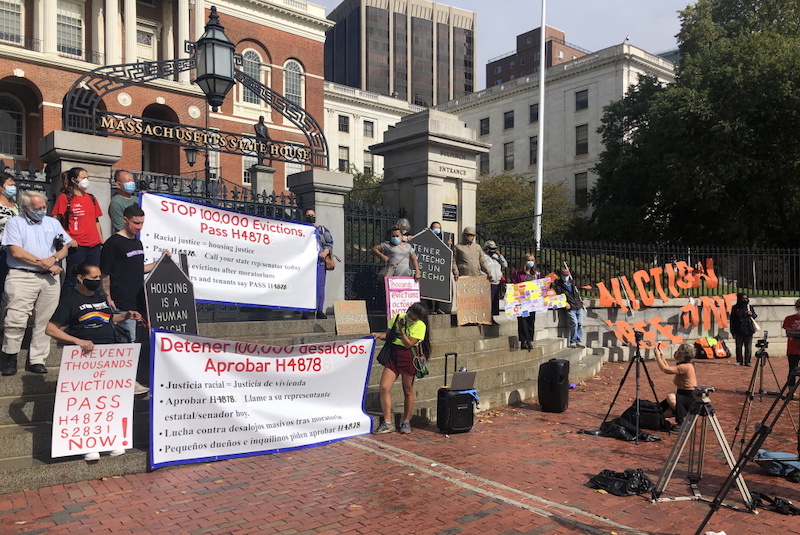Causes
Report: Court Intervention Could Prevent Eviction Wave in Massachusetts

By Chris Lisinski
The Massachusetts judiciary should intervene to prevent a potential surge of tens of thousands of housing removals that could hit when the state’s temporary ban on evictions and foreclosures expires this month, a regional planning agency urged in a new report.
At least 80,000 households in Massachusetts, including both renters and homeowners, will struggle to cover the costs of both housing and basic needs this month, the Metropolitan Area Planning Council concluded after studying unemployment and Census Bureau data.
With the moratorium expiring on Oct. 17, it is likely too late for policy solutions such as increasing rental assistance, offering legal assistance to tenants, or implementing foreclosure protection for struggling landlords, the council representing 101 cities and towns in the greater Boston region said.
Instead, the group directed its message to the state’s Housing Court and to the Baker administration.
Judicial leaders should delay all non-essential eviction hearings until at least Jan. 1, MAPC said, and Gov. Charlie Baker — who has already indicated he may not keep the ban in place- – should use his authority to extend the moratorium to the end of the year.
“Without federal, state, or court intervention, Massachusetts is likely to see a significant wave of evictions and foreclosures in the coming months,” MAPC authors wrote in the report published Monday. “As a result, more people may find themselves homeless or living in overcrowded housing — circumstances that contribute to the spread of COVID-19 and may extend the length of the pandemic. Small landlords unable to cover mortgage payments due to lost rent may be forced to sell their rental properties, accelerating the consolidation of the rental real estate market under the control of large corporate owners and trusts.”
The COVID-19 pandemic and the national recession it caused has created widespread housing uncertainty, particularly for workers who are less able to perform jobs remotely and more likely to face layoffs.
While the number of Massachusetts residents receiving unemployment benefits has been declining for several months, MAPC authors warned that financial conditions are likely more strained for those who still need aid now that all sources of supplemental funding — including the CARES Act’s additional $600 per week and a subsequent $300 per week through the Lost Wages Assistance program — have expired.
As of Sept. 5, more than 330,000 Massachusetts workers, representing about one-tenth of the labor force, continued to receive standard unemployment assistance, MAPC wrote.
The organization estimated that 45,000 renter households across Massachusetts and 35,000 owner households where a resident is on traditional unemployment benefits will struggle to cover both housing costs and basic needs in October.
Those numbers have declined since an earlier MAPC estimate in July, but the group warned that the gaps between available income and housing costs for households relying on joblessness aid are significant.
Renter households in Massachusetts who receive unemployment benefits collectively face a $42.3 million monthly shortfall between their expenses and available income, while homeowner households in the same situation face a gap of $44 million per month.
For renters, the gaps are greatest in cities with larger populations and with significant percentages of low-income or non-white residents. Boston’s gap in October is about $10.4 million, nearly 10 times as much as any other municipality, followed by Springfield at $1.4 million, Lawrence at $1.2 million, Revere at $1.1 million, Worcester at $1.05 million and Lynn at $1.01 million.
About 60,000 renter households fear “imminent eviction” as they face the end of the moratorium in less than two weeks, MAPC said.
Authors also noted their estimates likely underrepresent the scale of the need because of incomplete data. Undocumented workers are not counted because they do not qualify for unemployment aid, but they occupy about 25,000 households that are “highly vulnerable to both eviction and COVID,” they wrote.
“We also know that tens of thousands of other households are also in trouble, although their numbers are more difficult to estimate,” MAPC wrote. “This includes people receiving (Pandemic Unemployment Assistance), undocumented workers who can’t apply for unemployment at all, workers with reduced hours and wages, and households who are working again but owe back rent.”
Supporters argue the temporary ban on housing removals helps protect residents from exposure to the pandemic, warning that a flood of evictions and foreclosures could increase homelessness or crowding while a highly infectious virus continues to pose threats.
Baker signed the moratorium into law in April, then extended it in July until Oct. 17. He can continue to extend it in increments up to 90 days while the public health state of emergency is in place.
Last month, Baker hinted he might allow the policy to expire and said he is talking with judicial leaders and housing groups about a possible solution.
He said again on Tuesday that his administration is working with the courts to create some kind of program to succeed the moratorium.
“We’ve been spending a lot of time with our colleagues in the court system and in the housing community, and our goal is to put together a program that makes sure we create what we would describe as stabilization for people,” Baker said at a press conference. “But we need to create a process here and we need to get moving on delivering on that process.”
The Legislature’s Housing Committee voted 14-3 last week to advance a bill that would keep a moratorium in place for one year after the health crisis ends, freeze rents in the interim, and create a fund to help small landlords.
Democratic legislative leaders have not signaled any plans to take that bill up in the House or Senate.
-

 Community7 years ago
Community7 years agoNational Shrine of La Salette Festival of Lights 2017 set to begin
-

 Community6 years ago
Community6 years agoMassachusetts State Police looking for good home for retired dogs
-

 Crime6 years ago
Crime6 years agoFall River ranked most dangerous city in Massachusetts according to report
-

 latest7 years ago
latest7 years agoDurfee student allegedly overdoses on marijuana
-

 Community6 years ago
Community6 years agoVideo of Fall River Police goes viral
-

 Causes6 years ago
Causes6 years agoMissing Fall River woman found deceased
-

 Crime6 years ago
Crime6 years agoFall River Police add names to most wanted list
-

 Causes6 years ago
Causes6 years agoFall River teenager reported missing has been found



